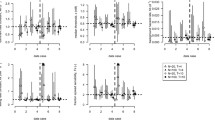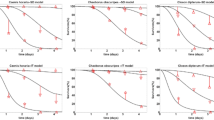Abstract
In chemical risk assessment, extrapolations from laboratory tests to more realistic conditions are essential to address the toxic effects of pesticides on individuals and populations under field conditions. To transfer toxicological laboratory tests to differing temperature conditions, or outdoor field scenarios, the consideration of temperature dependence is essential and increases realism. Special consideration is given to the impact of temperature on direct sensitivity of organisms to pesticides, for which there are only few modelling approaches available so far. We present a concept for applying physiological temperature dependencies to toxicokinetic–toxicodynamic (TKTD) parameters in the General Uniformed Threshold model of Survival (GUTS). To test this approach in an exemplary study, temperature dependencies from studies on the developmental rate of the mayfly Cloeon dipterum were applied to the parameters of a previously parameterised TKTD model of this species after exposure to imidacloprid. Using a physiologically derived temperature correction for the TKTD rate constants, model predictions for independently conducted toxicology experiments with temperature ranges between 7.8 and 26.4 °C were performed for validation. Our approach demonstrates the successful transfer of a physiological observed temperature dependency on toxicity parameters and survival patterns for Cloeon dipterum and imidacloprid as a case study.



Similar content being viewed by others
References
Ashauer R, Escher BI (2010) Advantages of toxicokinetic and toxicodynamic modelling in aquatic ecotoxicology and risk assessment. J Environ Monit 12:2056. https://doi.org/10.1039/c0em00234h
Ashauer R, Albert C, Augustine S, Cedergreen N, Charles S, Ducrot V, Preuss TG (2016) Modelling survival: exposure pattern, species sensitivity and uncertainty. Sci Rep 6(1):1–11
Bat L, Akbulut M, Çulha M, Gündoğdu A, Satilmiş HH (2000) Effect of temperature on the toxicity of zinc, copper and lead to the freshwater amphipod Gammarus pulex pulex (L., 1758). Turk J Zool 24(4):409–416
Baudrot V, Charles S (2021) morse: an R-package in support of environmental risk assessment. J. Open Source Softw 6:3200. https://doi.org/10.21105/joss.03200
Becker D (2011) Sensitivity distinctions of lotic insect larvae exposed to imidacloprid. Diploma Thesis, RWTH Aachen University
Bednarska AJ, Jevtić DM, Laskowski R (2013) More ecological ERA: incorporating natural environmental factors and animal behavior. Integr Environ Assess 9(3):e39–e46
Cairns Jr J, Heath AG, Parker BC (1975) Temperature influence on chemical toxicity to aquatic organisms. J Water Pollut Conf, 267–280
Camp AA, Buchwalter DB (2016) Can’t take the heat: Temperature-enhanced toxicity in the mayfly Isonychia bicolor exposed to the neonicotinoid insecticide imidacloprid. Aquat Toxicol 178:49–57. https://doi.org/10.1016/j.aquatox.2016.07.011
Cedergreen N, Nørhave NJ, Svendsen C, Spurgeon DJ (2016) Variable temperature stress in the nematode Caenorhabditis elegans (Maupas) and its implications for sensitivity to an additional chemical stressor. PLoS ONE 11(1):e0140277
Delnat V, Tran TT, Verheyen J, Van Dinh K, Janssens L, Stoks R (2019) Temperature variation magnifies chlorpyrifos toxicity differently between larval and adult mosquitoes. Sci Tot Environ 690:1237–1244
Dohmen GP, Preuss TG, Hamer M, Galic N, Strauss T, van den Brink PJ, Bopp S (2016) Population-level effects and recovery of aquatic invertebrates after multiple applications of an insecticide. Integr Environ Asses 12(1):67–81
EFSA Panel on Plant Protection Products and their Residues (PPR), Ockleford C, Adriaanse P, Berny P, Brock T, Duquesne S, Grilli S, Hernandez-Jerez AF, Bennekou SH, Klein M, Kuhl T, Laskowski R, Machera K, Pelkonen O, Pieper S, Smith RH, Stemmer M, Sundh I, Tiktak A, Topping CJ, Wolterink G, Cedergreen N, Charles S, Reed FA, M, Arena M, Ippolito A, Byers H, Teodorovic I (2018) Scientific Opinion on the state of the art of Toxicokinetic/Toxicodynamic (TKTD) effect models for regulatory risk assessment of pesticides for aquatic organisms. EFSA J. https://doi.org/10.2903/j.efsa.2018.5377
Gergs A, Rakel KJ, Liesy D, Zenker A, Classen S (2019) Mechanistic effect modeling approach for the extrapolation of species sensitivity. Environ Sci Technol 53(16):9818–9825
Gergs A, Hager J, Bruns E, Preuss TG (2021) Disentangling mechanisms behind chronic lethality through toxicokinetic-toxicodynamic modeling. Environ Toxicol Chem 40:1706–1712. https://doi.org/10.1002/etc.5027
Goussen B, Rendal C, Sheffield D, Butler E, Price OR, Ashauer R (2020) Bioenergetics modelling to analyse and predict the joint effects of multiple stressors: meta-analysis and model corroboration. Sci Total Environ 749:141509. https://doi.org/10.1016/j.scitotenv.2020.141509
Harwood AD, You J, Lydy MJ (2009) Temperature as a toxicity identification evaluation tool for pyrethroid insecticides: toxicokinetic confirmation. Environ Toxicol Chem 28(5):1051–1058
Heugens EH, Hendricks AJ, Dekker T, van Straalen NM, Admiraal W (2001) A review of the effects of multiple stressors on aquatic organisms and analysis of uncertainty factors for use in risk assessment. Crit Rev Toxicol 31(3):247–284
Heugens EH, Jager T, Creyghton R, Kraak MH, Hendriks AJ, Van Straalen NM, Admiraal W (2003) Temperature-dependent effects of cadmium on Daphnia magna: accumulation versus sensitivity. Environ Sci Technol 37(10):2145–2151
Holmstrup M, Bindesbøl AM, Oostingh GJ, Duschl A, Scheil V, Köhler HR, Loureiro S, Soares AMVM, Ferreira ALG, Kienle C, Gerhardt A, Laskowski R, Kramarz PE, Bayley M, Svendsen C, Spurgeon DJ (2010) Interactions between effects of environmental chemicals and natural stressors: a review. Sci Total Environ 408(436):3746–3762
Hooper MJ, Ankley GT, Cristol DA, Maryoung LA, Noyes PD, Pinkerton KE (2013) Interactions between chemical and climate stressors: a role for mechanistic toxicology in assessing climate change risks. Environ Toxicol Chem 32(1):32–48
Huang A, van den Brink NW, Buijse L, Roessink I, van den Brink PJ (2021) The toxicity and toxicokinetics of imidacloprid and a bioactive metabolite to two aquatic arthropod species. Aquat Toxicol 235:105837
Jacobs CMJ, Deneer JW, Adriaanse PI (2010) Modelling water temperature in TOXSWA. Alterra Report 2099, ISSN 1566-7197
Jager T, Albert C, Preuss TG, Ashauer R (2011) General unified threshold model of survival—a toxicokinetic-toxicodynamic framework for ecotoxicology. Environ Sci Technol 45:2529–2540. https://doi.org/10.1021/es103092a
Jager T, Ashauer R (2018) Modelling survival under chemical stress. A comprehensive guide to the GUTS framework, Version 1.0. ed. LeanPub
Jørgensen SE (1983) Modeling the ecological processes. Mathematical modeling of water quality: streams, lakes, and reservoirs. International Series on Applied Systems Analysis, 116–149
Kooijman SALM (2010) Dynamic energy budget theory for metabolic organisation, 3rd edn. Cambridge University Press, Cambridge
Kooijman B, Augustine S, Rakel KJ, Liesy D, Gergs A (2020) AmP Cloeon dipterum
Kooijman B, Lika D, Augustine S, Kearney MR, Marn N (2021). Add-my-Pet [WWW Document]. Database Code Data DEB Model Parameters. https://www.bio.vu.nl/thb/deb/deblab/add_my_pet/
Kraemer BM, Pilla RM, Woolway RI, Anneville O, Ban S, Colom-Montero W, Adrian R (2021) Climate change drives widespread shifts in lake thermal habitat. Nat Clim Change 11(6):521–529
Lydy MJ, Belden JB, Ternes MA (1999) Effects of temperature on the toxicity of M-parathion, chlorpyrifos, and pentachlorobenzene to Chironomus tentans. Arch Environ Con Tox 37(4):542–547
Ma YH, Gao ZL, Dang ZH, Li YF, Pan WL (2012) Effect of temperature on the toxicity of several insecticides to Apolygus lucorum (Meyer-Dür). J Pestic Sci 1203090227–1203090227
Macaulay SJ, Buchwalter DB, Matthaei CD (2020) Water temperature interacts with the insecticide imidacloprid to alter acute lethal and sublethal toxicity to mayfly larvae. N Z J Mar Fresh 54(1):115–130
Marques GM, Augustine S, Lika K, Pecquerie L, Domingos T, Kooijman SALM (2018) The AmP project: Comparing species on the basis of dynamic energy budget parameters. PLOS Comput Biol 14:e1006100. https://doi.org/10.1371/journal.pcbi.1006100
McElroy AE, Barron MG, Beckvar N, Driscoll SBK, Meador JP, Parkerton TF, Steevens JA (2011) A review of the tissue residue approach for organic and organometallic compounds in aquatic organisms. Integr Environ Asses 7(1):50–74
Nauen R, Ebbinghaus-Kintscher U, Schmuck R (2001) Toxicity and nicotinic acetylcholine receptor interaction of imidacloprid and its metabolites in Apis mellifera (Hymenoptera: Apidae). Pest Manag Sci 57:577–586. https://doi.org/10.1002/ps.331
OECD (2012) Test No. 211: Daphnia magna Reproduction Test, OECD Guidelines for the Testing of Chemicals, Section 2. OECD Publishing, Paris. https://doi.org/10.1787/9789264185203-en
Op de Beeck LO, Verheyen J, Stoks R (2017) Integrating both interaction pathways between warming and pesticide exposure on upper thermal tolerance in high-and low-latitude populations of an aquatic insect. Environ Poll 224:714–721
R Development Core Team (2008) R: A Language and Environment for Statistical Computing. R Foundation for Statistical Computing, Vienna, Austria
Ratte HT (1984) Temperature and insect development. In Environmental physiology and biochemistry of insects, pp 33–66. Springer, Berlin
Rico A, Arenas-Sánchez A, Pasqualini J, García-Astillero A, Cherta L, Nozal L, Vighi M (2018) Effects of imidacloprid and a neonicotinoid mixture on aquatic invertebrate communities under Mediterranean conditions. Aquat Toxicol 204:130–143
Sowa R (1975) What is Cloeon dipterum (Linnaeus, 1761)? Insect Syst Evol 6(3–4):215–223. https://doi.org/10.1163/187631275X00046
Sumon KA, Ritika AK, Peeters ET, Rashid H, Bosma RH, Rahman MS, Van den Brink PJ (2018) Effects of imidacloprid on the ecology of sub-tropical freshwater microcosms. Environ Poll 236:432–441
Sweeney B, Funk D, Camp A, Buchwalter D, Jackson J (2018) Why adult mayflies of Cloeon dipterum (Ephemeroptera: Baetidae) become smaller as temperature warms. Freshw Sci 37(1):64–81
Van den Brink PJ, Van Smeden JM, Bekele RS, Dierick W, De Gelder DM, Noteboom M, Roessink I (2016) Acute and chronic toxicity of neonicotinoids to nymphs of a mayfly species and some notes on seasonal differences: Toxicity of neonicotinoids to mayfly nymphs. Environ Toxicol Chem 35:128–133. https://doi.org/10.1002/etc.3152
Van Dinh K, Janssens L, Debecker S, Stoks R (2014) Temperature-and latitude-specific individual growth rates shape the vulnerability of damselfly larvae to a widespread pesticide. J Appl Ecol 51(4):919–928
Wagner TL, Wu HI, Sharpe PJH, Schoolfield RM, Coulson RN (1984) Modeling insect development rates: a literature review and application of a biophysical model. Ann Entomol Soc A 77(2):208–225
Yano K, Takenaka M, Tojo K (2019) Genealogical position of Japanese populations of the globally distributed mayfly Cloeon dipterum and related species (Ephemeroptera, Baetidae): a molecular phylogeographic analysis. Zool Sci 36(6):479–489
Acknowledgements
The authors thank Margret Arnold, Timm Knautz and Nils Lippmann for their assistance in the laboratory.
Funding
This work was supported by Bayer AG.
Author information
Authors and Affiliations
Contributions
The study was conceptualised by AG. Experimental studies were planned, conducted and/or supervised by SC, DB, TP and AG. Analytical measurements of imidacloprid for the validation data set 2 (Becker 2011) were performed and provided by AZ. Data analysis and modelling were performed by KR, DB, TS and AG. The first draft of the manuscript was written by KR and TS, and all authors commented on previous versions of the manuscript. All authors read and approved the final manuscript.
Corresponding author
Ethics declarations
Competing interests
Financial interests: Authors Kim Rakel, Dino Bussen, Silke Classen and Tido Strauss have received research funding from Bayer AG. Dennis Becker and Armin Zenker declare they have no financial interests. André Gergs and Thomas Preuss are employed at Bayer AG. Imidacloprid is an active ingredient in Bayer products.
Supplementary Information
Below is the link to the electronic supplementary material.
Rights and permissions
Springer Nature or its licensor (e.g. a society or other partner) holds exclusive rights to this article under a publishing agreement with the author(s) or other rightsholder(s); author self-archiving of the accepted manuscript version of this article is solely governed by the terms of such publishing agreement and applicable law.
About this article
Cite this article
Rakel, K., Becker, D., Bussen, D. et al. Physiological Dependency Explains Temperature Differences in Sensitivity Towards Chemical Exposure. Arch Environ Contam Toxicol 83, 349–360 (2022). https://doi.org/10.1007/s00244-022-00963-2
Received:
Accepted:
Published:
Issue Date:
DOI: https://doi.org/10.1007/s00244-022-00963-2




